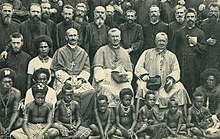geo.wikisort.org - Island
Yule Island is a small island in Central Province, Papua New Guinea. It is located 160 km NW from Port Moresby, on the south coast of Papua New Guinea.
 Yule Island Location of Yule Island in Papua New Guinea | |
| Geography | |
|---|---|
| Coordinates | 8°49′S 146°32′E |
| Administration | |
Papua New Guinea | |
| Province | Central Province |
History

Yule Island was probably named after Charles Bampfield Yule, a Royal Navy officer who surveyed the area from 1842–1845.[1] It was one of the first areas in Central Province to have contact with Europeans. The Catholic Missionaries of the Sacred Heart began a mission in 1885.[2] The mission was successfully led from 1900 to 1945 by Bishop Henry Verius.[3]
With the European missionaries came catechists from the Philippines, some of which married into the local population. Today, many inhabitants of Yule Island have distinct European and Filipino features.[4]
The visit of Australian poet James McAuley to the mission at Yule Island in 1949 made a profound spiritual impression on him and contributed to his conversion to Catholicism.[5]
Fauna
Yule Island is surrounded by coral reefs.[6]
Several spider species are endemic to this island, including:[7]
- The jumping spider species Salticus perogaster and Plexippus brachypus
- Heteropoda cyanognatha and Pandercetes longipes (Sparassidae)
- Misumena arrogans and Stephanopis yulensis (Thomisidae)
The Early Pliocene Echinodermata fauna is rich and diverse, with 19 species known to occur in the Kairuku Formation. Nearly half of these species are also represented in northern Australia stocks, with the northern Great Barrier Reef only 600 km away.[8]
Notable people
- Susan Karike - designer of the flag of Papua New Guinea
- Louis-André Navarre - Missionary of the Sacred Heart and Archbishop, worked on the island and, following his death and burial in Townsville, was exhumed and reburied on the island[9]
References
- Quanchi, Historical Dictionary of the Discovery and Exploration of the Pacific Islands, page 251
- Sr Antoninus (1985). "Birds of paradise and drums that announce Christ's peace". Annals Australasia. Archived from the original on 7 Sep 2015. Retrieved 18 Jul 2020.
- R. Tamamai, Yule Island's pioneer Bishop de Boismenu on the path to sainthood, PNG Attitude, 26 Apr 2014.
- Hernandez
- J. Page, Land of Apocalypse – James McAuley’s encounter with the Spirit: the French Catholic Mission of the Sacred Heart, Kubuna, New Guinea, Journal of the Australian Catholic Historical Society, 37 (1) (2016), 18-31.
- Papua New Guinea Tourism Promotion Authority
- World Spider Catalog
- nomen nudum 28: report 2001-2002 Archived September 2, 2007, at the Wayback Machine
- "Centenary of Archbishop Navarre MSC". Missionaries of the Sacred Heart. Retrieved 2022-08-02.
- Papua New Guinea Tourism Promotion Authority: Central Province
- Platnick, Norman I.(2007): The world spider catalog, version 8.0. American Museum of Natural History.
Further reading
- Lindley, I. David (2003): Echinoids of the Kairuku Formation (Lower Pliocene), Yule Island, Papua New Guinea: Clypeasteroida. Regularia. Spatangoida. Proceedings of the Linnean Society of New South Wales 124: 125–162.
- Lindley, I. David (2004): The Yule Island fauna and the origin of tropical northern Australian echinoid (Echinodermata) faunas. Proceedings of the Linnean Society of New South Wales 125: 97-109.
На других языках
- [en] Yule Island
[fr] Île Yule
L'île Yule est une île de Papouasie-Nouvelle-Guinée.[it] Yule (isola)
L'isola di Yule è un'isola della Papua Nuova Guinea, che si trova nel sud della Nuova Guinea, 160 km a nord di Port Moresby lungo la costa. Amministrativamente fa parte del Distretto di Kairuku-Hiri nella Provincia Centrale, appartenente alla Regione di Papua.Другой контент может иметь иную лицензию. Перед использованием материалов сайта WikiSort.org внимательно изучите правила лицензирования конкретных элементов наполнения сайта.
WikiSort.org - проект по пересортировке и дополнению контента Википедии